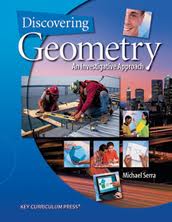


*[OFF TRACK] Geometry I
Test Schedule:
March 21-24: QUIZ CHAPTER 4, 4.1-4.5
April 2-3: TEST CHAPTER 4
April 22-23: QUIZ CHAPTER 5
May 6-7: TEST CHAPTER 5
May 16-17: QUEST CHAPTER 6, 6.1-6.3 & Exploration
FINAL EXAMS:
May 23: B1 & B3
May 27: G3
May 28: B2 & B4
May 29: G1 & G4
During the second 9 weeks, we will spend a lot of time adding to what we've already learned about how sides and angles of triangles are related and how different triangles are related to one another. We will also begin to describe the family of quadrilaterals, many times in terms of the triangles they into which they can be broken down and focus our reasoning skills on categorizing their distinguishing properties. We will finish the semester with an introductory look at circles and relationships involving tangent lines, radii, chords, arcs and angles.
Geometry II
Test Schedule:
March 21-24: Right Triangle Review Quiz
March 31-April 1: QUEST CHAPTER 12, 12.1-12.2
April 22-23: QUIZ CHAPTER 11, 11.1-11.4
May 2-5: TEST CHAPTER 11,
May 12-13: QUIZ CHAPTER 7, 7.1-7.2
FINAL EXAMS:
May 23: B1 & B3
May 27: G3
May 28: B2 & B4
May 29: G1 & G4
After we put a lid on Chapter 10 and solid polyhedra geometry by studying spheres and introducing the concepts of displacement and density, we will venture into the concept of similarity and use proportions to relate measures both directly and indirectly. We will study proportionality in one dimension (length), two dimensions (area), and three dimensions (volume). This will accommodate a nice review of topics form the last couple of chapters. We will look into Chapter 12 just enough to provide an introduction to trigonometry and the basic ratios of sine, cosine, and tangent. We will finish the semester by exploring the orientation of our entire collection of two-dimensional figures, as they move within the plane. These transformations deal exclusively with rigid motion and dilation. They only affect the position, orientation and/or size of a figure. As time allows we may apply some statistics and probability and look at them from the perspective of measurement and geometry.


Geometry Course Information
There's only one reason that Geometry is a required part of the high school curriculum, and it's not a lack of faith in Kindergarden teachers' abilities to teach shapes. It's not the formulas or even the arithmetic. Actually, there is no new math to be learned here--no tricks or shortcuts or new operations. Those all await you in Algebra 2, Trigonometry, and Calculus.
Geometry is a way of thinking. It's all about logic, reasoning, relationships and basically just figuring stuff out. The sooner students can forget about the "math" and the shapes, the better off they will be. Geometry is a branch of mathematics that is more elegantly expressed through logic and reasoning than any other discipline. This is the only course in all of high school dedicated to training your brain to reason, to explore all possibilities, and to confidently discount those that are impossible. It's argueably the most practical and useful math course you will ever take if you approach it in the manner in which it is intended.
Brain research suggests that the development of the cognitive skills needed to think this way don't even begin to develop until about the age a student is expected to take this course. For this reason, some may be more "ready" than others. But I think any student who approaches Geometry with an open mind can be successful.
What are we doing right now? Click here to find out.

